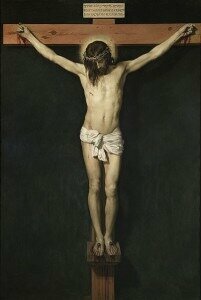
Dali : Christ of Saint John of the Cross
Credit: http://www.wikiart.org/
| Sancta Mater, istud agas Crucifixe fige plagas Cordi meo valide. | Holy Mother, pierce me through in my heart each wound renew of my Saviour crucified. |
With such a combination, it is not surprising that the Stabat Mater has proved a major inspiration for composers. The text enjoyed frequent settings during the Renaissance and Baroque eras by composers like Josquin des Prez, Palestrina, Vivaldi and Pergolesi. Many of these settings were for a full choir, but some of them, like Vivaldi’s and Pergolesi’s, used a solo voice (in Pergolesi’s setting, two of them) to heighten the personal nature of the text. Stabat Maters by Romantic composers are scarce; the only settings regularly performed today are large works for soloists, chorus and orchestra by Dvorak, whose opening rising octaves suggests Mary’s eyes gazing up at the cross, and Rossini. More recently, the hymn’s searing imagery has provided fruitful material for 20th century composers, such as Francis Poulenc and Karol Szymanowski, and 21st century composers such as Arvo Pärt and Giles Swayne.
The Genesis Foundation, in association with British choir The Sixteen, have committed to the continuity of this tradition by commissioning new settings of the Stabat Mater from composers Alissa Firsova, Tõnu Kõrvits and Matthew Martin. The three composers come from excitingly different backgrounds. Martin has a background in church music, including work at Magdelen College, Oxford, Westminster Cathedral and the London Oratory, and is regularly commissioned by choirs in the UK. Kõrvits, from Estonia, has inherited the tradition of fellow Estonians Arvo Pärt and Veljo Tormis and writes music for a wide range of ensembles. Firsova is a remarkably versatile musician who sustains an international career as composer, conductor and pianist, and has recently written works for Imogen Cooper, the Dante Quartet and the Royal Philharmonic Orchestra.

Veláquez : Cristo crucificado
Credit: Wikipedia
New settings of the Stabat Mater by Alissa Firsova, Tõnu Kõrvits and Matthew Martin will receive their world premiere performances at LSO St Luke’s on Wednesday 4 June in a free lunchtime concert given by The Sixteen, conducted by Harry Christophers. The programme will be repeated later that day at an evening concert at the Victoria and Albert Museum.
Official Website
Stabat Mater 2014: Strength, Strength & Sorrow

